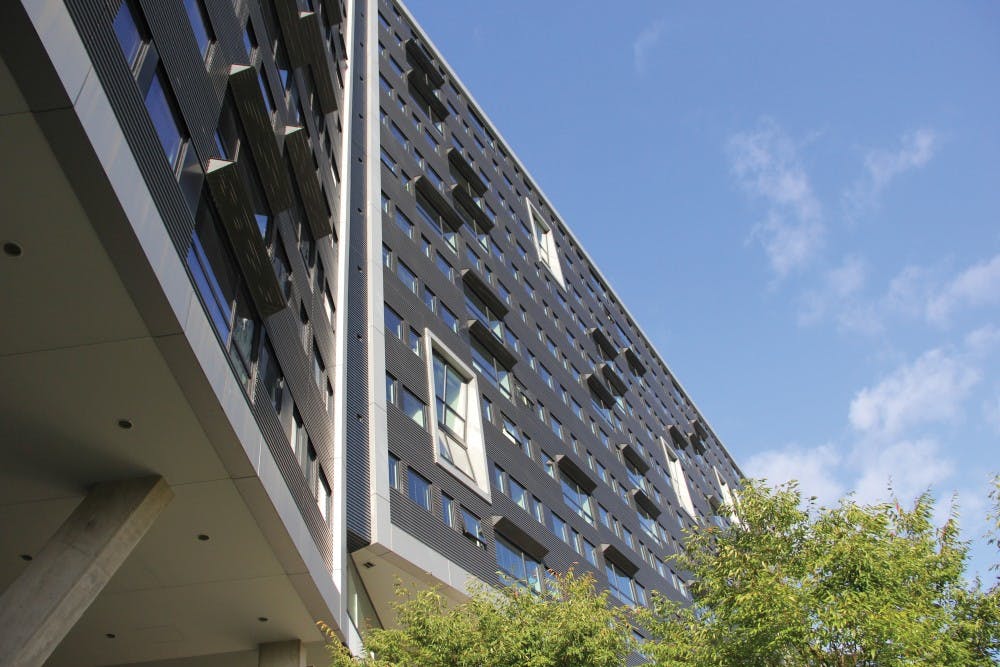
Housing arrangments may cause a physical and social-economical divide on Penn campus//Carson Kahoe | Staff Photographer
Credit: Carson KahoeWelcome to the Radian: Where lush couches, flat-screen televisions and spiral staircases fill duplex lounges, where gyms with state-of-the-art equipment have windows that extend from the floor to the ceiling and where modern kitchens are furnished with the newest appliances.
This is home for Penn’s wealthy undergraduates — that is, besides those who live in Domus Apartments, with its second-floor pool, private theater and spa-inspired bathrooms.
Just a few blocks west live many lower-income students in off-campus apartments that typically cost less than half the Radian’s rent. For these students, amenities are few and far between, and landlords can be unresponsive.
“I definitely think income disparities affect housing. Obviously, if you have more money you can afford to live in a nicer place,” said College sophomore Rita Wegner. “I would never consider living in the Radian or Domus. If it’s more expensive than on campus, then no way. That’s not happening.”
Because so many students become friends with their roommates and hallmates, these housing divisions can often lead to social divisions. “I really don’t know anyone who lives [in the Radian] because I don’t know anyone in those circles,” Wegner said.
But not all students think housing exacerbates income disparities at Penn. “A lot of people live on campus because of the community,” said College sophomore Lauren Murski. And Wegner, who went to the opera with her hall earlier this semester, agrees that on-campus programming, study-breaks and trips are definitely a draw to live on campus.
Any housing disparities that do exist are most evident among upperclassmen. “I feel like the differences are more so junior and senior year because sophomore year people just live on campus because it is easier,” said Nursing sophomore Erin Hartman.
Housing disparities exist because so many Penn students — 41 percent — live off campus in luxury or more affordable housing units. Among upperclassmen, who unlike freshmen are not mandated to live on campus, that percentage is even higher.
This is not necessarily the case at other Ivy League universities. At Harvard and Yale, for example, 97 and 86 percent of students live on campus, respectively. As a result, students of all income-levels and backgrounds more easily become roommates, hall mates and best friends throughout their four years as undergraduates.
“There isn’t really any reflection of income inequality in the housing system because it is totally randomized,” said Harvard sophomore Aaron Miller. “Toward the end of freshman year, every one is randomly assigned one of the twelve houses and you usually stay there for three years.”
New York University, by contrast, is on the other extreme. There, because of the plethora of nearby off-campus housing options, 56 percent of students live off campus, and housing is divided among those who can afford to live in New York’s most expensive neighborhoods and those who cannot. Even on-campus housing at NYU is divided along income lines, with some housing options costing more than others.
Penn students are quick to point out that, at the end of the day, housing doesn’t cause income disparities — it simply reveals already existing issues.
“Income is more than just a number. It’s also a lifestyle: where you eat, how you eat, what you do, [and] how you grew up,” Wegner said.
The Daily Pennsylvanian is an independent, student-run newspaper. Please consider making a donation to support the coverage that shapes the University. Your generosity ensures a future of strong journalism at Penn.
DonatePlease note All comments are eligible for publication in The Daily Pennsylvanian.





